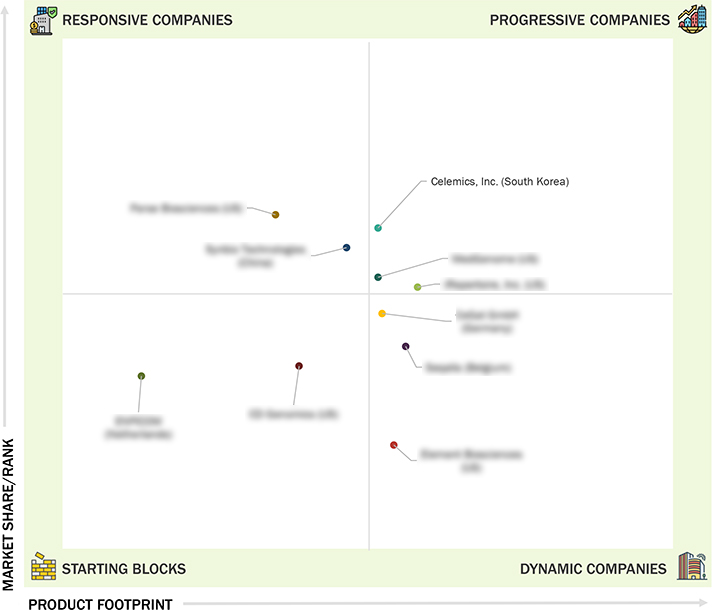Comparing 10 vendors in Immune Repertoire Sequencing Startups across 0 criteria.
The Immune Repertoire Sequencing (IRS) market is projected to grow significantly from 2025 to 2030, driven by technological advancements, personalized medicine, organ transplant monitoring, autoimmune research, and cancer immunotherapy. AI and ML integration and vaccine development present growth opportunities. However, challenges such as high capital investments and regulatory barriers exist. The market is segmented by products, technologies, workflows, applications, and end users, with North America leading due to robust healthcare infrastructure and significant R&D investments. The Asia Pacific region is expected to exhibit the fastest growth, driven by an expanding healthcare sector and rising government initiatives.
Market Leadership Quadrant
1.1 Study Objectives
1.2 Market Definition
1.3 Study Scope
1.3.1 Markets Covered and Regional Scope
1.3.2 Inclusions and Exclusions
1.3.3 Years Considered
1.4 Currency Considered
1.5 Unit Considered
1.6 Limitations
1.7 Stakeholders
2.1 Introduction
2.2 Market Dynamics
2.2.1 Drivers
2.2.1.1 Increasing technological advancements
2.2.1.2 Growing focus on personalized/precision medicines
2.2.1.3 Increasing Use of immune repertoire sequencing in organ transplant monitoring
2.2.1.4 Increasing applications in autoimmune disease research
2.2.1.5 Rising focus on cancer immunotherapy research
2.2.2 Restraints
2.2.2.1 Need for high capital investments
2.2.2.2 Limited clinical adoption and validation
2.2.3 Opportunities
2.2.3.1 Integration of AI and ML into immune repertoire sequencing
2.2.3.2 Increasing applications in vaccine development
2.2.4 Challenges
2.2.4.1 Variations in regulatory frameworks and international trade dynamics
2.2.4.2 Lack of workflow and data standardization
2.3 Trends/Disruptions Impacting Customer Business
2.4 Value Chain Analysis
2.5 Ecosystem Analysis
2.6 Investment and Funding Scenario
2.7 Technology Analysis
2.7.1 Key Technologies
2.7.2 Complementary Technologies
2.7.3 Adjacent Technologies
2.8 Patent Analysis
2.9 Trade Analysis
2.10 Porter’s Five Forces Analysis
2.10.1 Threat of New Entrants
2.10.2 Threat of Substitutes
2.10.3 Bargaining Power of Suppliers
2.10.4 Bargaining Power of Buyers
2.10.5 Intensity of Competitive Rivalry
3.1 Introduction
3.2 Key Player Strategies/Right to Win
3.3 Revenue Analysis
3.4 Market Share Analysis
3.5 Company Valuation and Financial Metrics
3.6 Brand/Product Comparison
3.7 Company Evaluation Matrix: Startups/SMEs
3.7.1 Progressive Companies
3.7.2 Responsive Companies
3.7.3 Dynamic Companies
3.7.4 Starting Blocks
3.7.5 Competitive Benchmarking: Startups/SMEs
3.7.5.1 Detailed list of key startups/SMEs
3.7.5.2 Competitive benchmarking of key startups/SMEs
3.8 Competitive Scenario
3.8.1 Deals
3.8.2 Other Developments
4.1 Celemics, Inc
4.1.1 Business overview
4.1.2 Products/Solutions/Services offered
4.1.3 Recent developments
4.2 MedGenome
4.2.1 Business overview
4.2.2 Products/Solutions/Services offered
4.2.3 Recent developments
4.3 iRepertoire, Inc.
4.3.1 Business overview
4.3.2 Products/Solutions/Services offered
4.3.3 Recent developments
4.4 Synbio Technologies
4.4.1 Business overview
4.4.2 Products/Solutions/Services offered
4.4.3 Recent developments
4.5 Parse Biosciences
4.5.1 Business overview
4.5.2 Products/Solutions/Services offered
4.5.3 Recent developments
4.6 CeGat GmbH
4.6.1 Business overview
4.6.2 Products/Solutions/Services offered
4.6.3 Recent developments
4.7 Element Biosciences
4.7.1 Business overview
4.7.2 Products/Solutions/Services offered
4.7.3 Recent developments
4.8 Seqalis
4.8.1 Business overview
4.8.2 Products/Solutions/Services offered
4.8.3 Recent developments
4.9 ENPICOM
4.9.1 Business overview
4.9.2 Products/Solutions/Services offered
4.9.3 Recent developments
4.10 CD Genomics
4.10.1 Business overview
4.10.2 Products/Solutions/Services offered
4.10.3 Recent developments


 PharmiWeb.com
PharmiWeb.com
 Aug 2023
Aug 2023

